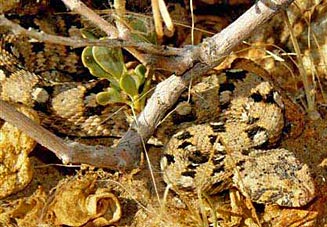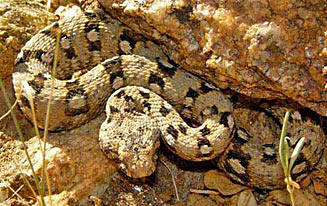|
Bitis xeropaga (Desert mountain adder)
Woestynbergadder [Afrikaans]
Life >
Eukaryotes
>
Opisthokonta >
Metazoa
(animals) > Bilateria > Deuterostomia >
Chordata >
Craniata > Vertebrata (vertebrates) > Gnathostomata (jawed vertebrates) >
Teleostomi (teleost fish) > Osteichthyes (bony fish) > Class:
Sarcopterygii (lobe-finned fish) > Stegocephalia (terrestrial vertebrates) >
Tetrapoda
(four-legged vertebrates) > Reptiliomorpha > Amniota >
Reptilia (reptiles) >
Romeriida > Diapsida > Lepidosauromorpha > Lepidosauria >
Squamata > Serpentes
(snakes) > Family: Viperidae > Genus:
Bitis
 |
 Bitis xeropaga (Desert Mountain adder),
Northern Cape [E.R Le Roux & B.A Le Roux ©
from
SARCA Virtual Museum] |
|
Bitis xeropaga (Desert Mountain adder),
Northern Cape [E.R Le Roux & B.A Le Roux ©
from
SARCA Virtual Museum] |
|
Identification
The Desert Mountain adder can be identified by its usually ash or
dark grey colouration, its unmarked head and between 16 and 34 white centered dark brown or
black markings that extend down the length of its body. This snake grows to an
average length of 40 cm but may reach a length of 61 cm.
Distribution and habitat
Has a restricted distribution in south-eastern Namibia and the extreme
north-eastern part of
the Northern Cape (although there is an isolated population in the Western
region of the province). Its favoured habitat is on mountain slopes and rocky
hillsides.
Food
Unknown, however captive specimens have been known to eat
lizards and
mice.
Predators, parasites and disease
Unknown, however it is threatened by unsustainable
collecting (it is quite popular amongst snake keepers).
Reproduction
Viviparous (gives birth to live young); four to five offspring
are born in late summer.
Longevity
Has an average lifespan of between five and
10 years.
Medical importance
No human bites have been recorded. It is thought
that this snake has a weak cytotoxic venom (which would cause nothing more than
pain and swelling). Antivenom is unnecessary.
Links
References
-
Broadley, D.G. 1983. FitzSimons' Snakes of Southern
Africa. Delta Books, Johannesburg.
-
Marais, J. 2004. A Complete Guide to Snakes of Southern Africa.
Struik Publishing, Cape Town.
|
